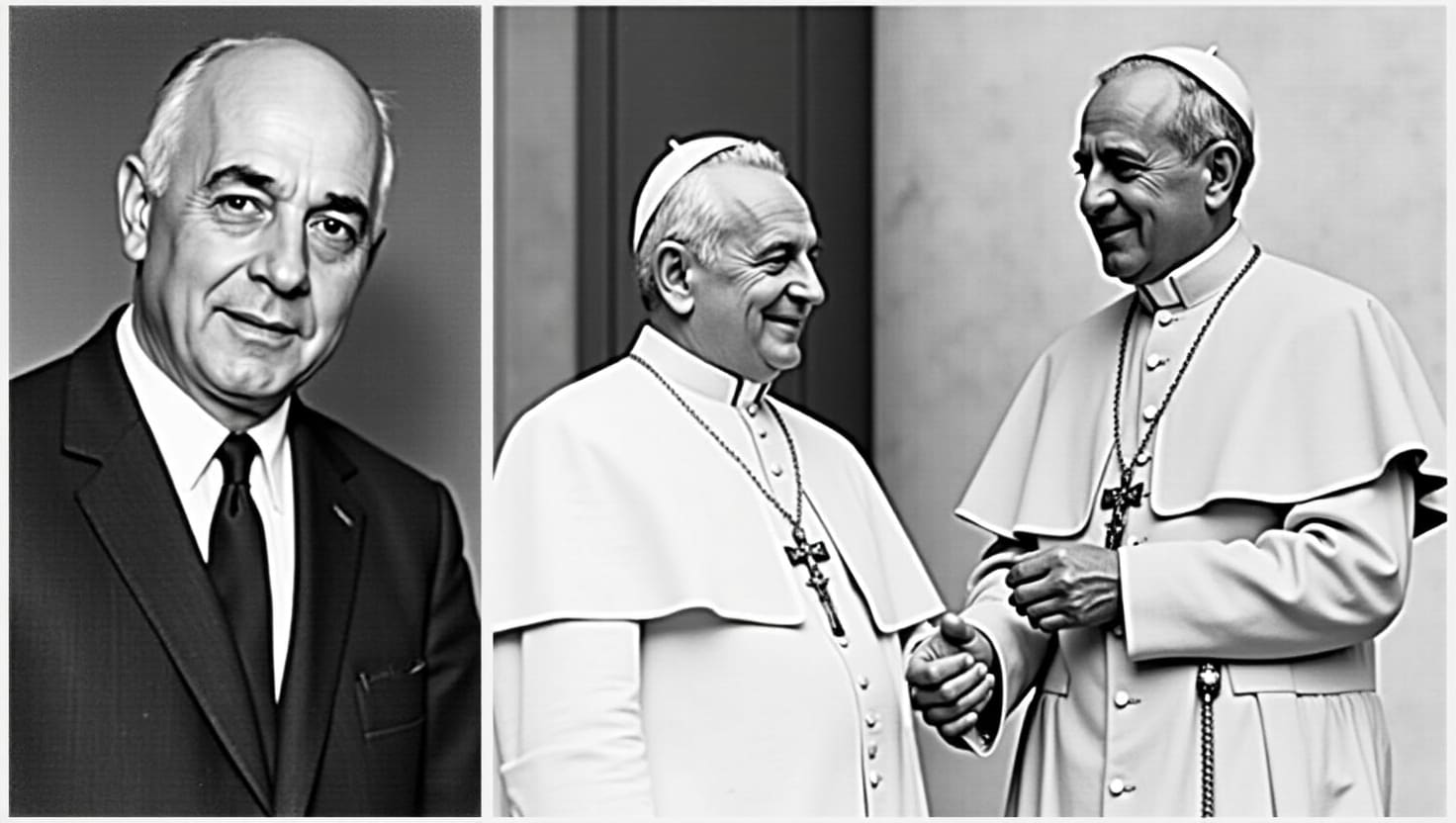In 1935, as the Cuban Ambassador to the Holy See, Dr. Juan Bautista Roig experienced firsthand the challenges and triumphs of strengthening diplomatic ties between Cuba and the Vatican. His personal commitment to preserving Cuba’s cultural identity while fostering moral governance left a lasting impact. Dr. Roig’s role set a new standard for future Cuban-Vatican relations.
In 1935, Cuba and the Vatican established formal diplomatic relations, with Dr. Juan Bautista Roig, the 1935 Cuban Ambassador to the Holy See, playing a key role. His efforts reinforced moral governance, strengthened bilateral ties, and set a precedent for future diplomatic relations.
This comprehensive guide 1935 Cuban Ambassador to the Holy See unravels the historical context, the ambassador’s contributions, and the far-reaching implications of this diplomatic relationship.
The Political and Diplomatic Climate of 1935

Global Context
The mid-1930s was a volatile period, with Europe grappling with the rise of fascist regimes in Italy and Germany. These developments posed significant challenges to global diplomacy and underscored the Vatican’s unique role as a moral authority amidst political turmoil.
The Holy See emerged as a critical player, mediating international tensions and fostering ethical governance.
Cuban Context
Back in Cuba, the political landscape was equally dynamic. President Carlos Mendieta, who took office in 1934, spearheaded efforts to stabilize the nation amid socio-economic unrest.
For Cuba, engaging with the Vatican represented an opportunity to reinforce moral governance and strengthen international alliances.
Who was the 1935 Cuban Ambassador to the Holy See?
In 1935, Dr. Juan Bautista Roig was appointed as the Cuban Ambassador to the Holy See. His selection highlighted Cuba’s commitment to strengthening ties with the Vatican. Dr. Roig played a pivotal role in representing Cuban interests during this crucial period.
His efforts contributed to solidifying the newly established diplomatic relationship. This appointment reflected Cuba’s acknowledgment of the Vatican’s global influence. It also emphasized the mutual interest in fostering closer collaboration.
Read also: The King’s Roses NWBKA – A Complete Guide
Historical Background of Cuba-Vatican Relations
Early Ties
Cuba’s relationship with the Vatican dates back to its colonial era under Spanish rule when Catholicism played a central role in shaping cultural and social norms.
Following independence in 1902, Cuba maintained its Catholic heritage and sought to formalize its ties with the Vatican to preserve these connections.
Religious and Cultural Connections
By 1935, Catholicism remained a cornerstone of Cuban identity, influencing education, social welfare, and governance. This enduring bond provided the foundation for Cuba’s diplomatic outreach to the Vatican.
Read also: HopTraveler.com – Your Ultimate Travel Companion
Appointment of the 1935 Cuban Ambassador to the Holy See

Selection Process
The appointment of the Cuban Ambassador to the Holy See in 1935 was a calculated decision aimed at promoting Cuba’s national interests on the global stage.
The ideal candidate needed a deep understanding of cultural diplomacy, exceptional negotiation skills, and a commitment to fostering mutual understanding.
Profile of the Ambassador
Though detailed records of the 1935 ambassador remain scarce, the role demanded an individual capable of bridging Cuba’s unique cultural identity with the Vatican’s spiritual and diplomatic influence. This appointment reflected Cuba’s ambition to align with the Vatican’s moral authority.
Challenges Faced by the Cuban Ambassador 1935 Cuban Ambassador to the Holy See
Political Instability in Cuba
The volatile political climate under President Mendieta created uncertainties in foreign policy, complicating the ambassador’s mission.
European and Vatican Dynamics
The Vatican itself was navigating complex relationships with totalitarian regimes, further influencing its interactions with foreign representatives like Cuba.
Religious Pluralism in Cuba
While Catholicism was the dominant religion, the ambassador had to navigate the growing presence of other religious communities, ensuring diplomatic harmony.
Read also: Wing Diamond Crosskeys Silver Hallmark – A Collector’s Treasure
Why was 1935 significant in Cuba-Vatican relations?
The year 1935 marked a pivotal moment in Cuba-Vatican relations. This was the year when formal diplomatic relations between the two entities were established, symbolizing Cuba’s recognition of the Vatican’s importance on the global stage and the mutual commitment to fostering cooperation.
This development reflected both parties’ desire to strengthen ties amidst the social and political changes occurring in Cuba.
Read also: WatchmenOnTheWallC Calvin – An Essential Guide
Key Contributions and Achievements
Strengthening Bilateral Relations
The Cuban ambassador played a vital role in fostering dialogue with the Vatican, emphasizing shared values and priorities such as education and social welfare.
Advocacy for Cuban Interests
Representing Cuba’s diverse cultural heritage, the ambassador helped shape the Vatican’s perception of Latin America as a region with unique contributions to the global Catholic community.
Promoting Religious Harmony
By highlighting Catholicism’s role in Cuban society, the ambassador reinforced the importance of religious cohesion and unity.
Broader Implications for Latin America
Regional Inspiration
Cuba’s proactive diplomacy with the Vatican set an example for other Latin American nations, encouraging them to strengthen their ties with the Holy See.
Strengthening Catholic Values in Governance
The ambassador’s work underscored the Vatican’s role as a unifying force, promoting ethical governance and social harmony across the region.
How did the Holy See influence Cuban diplomacy in the 1930s?
The Holy See played a significant role in Cuban diplomacy during the 1930s, particularly as Cuba sought to enhance its international standing and foster closer ties with religious institutions.
The Vatican’s influence extended to promoting dialogue and supporting moral frameworks within Cuba’s political and social landscape, reflecting the Catholic Church’s broader engagement in Latin America during this period.
Cultural and Diplomatic Exchanges
Art and Architecture
Cuban religious art and architectural styles were showcased to the Vatican, celebrating the nation’s rich cultural heritage.
Education Initiatives
The ambassador promoted Catholic education as a pillar of Cuban society, fostering collaboration on educational reforms.
Clergy and Theological Collaboration
The exchange of clergy and theological resources strengthened ties between Cuba and the Vatican, enriching both communities.
Read also: Bussola To Measure Angles Within A Circle Leonardo Da Vinci – The Angle Tool!
Legacy of the 1935 Ambassador 1935 Cuban Ambassador to the Holy See

Impact on Cuban Society
The ambassador’s work reinforced Catholic values in Cuban governance and daily life, contributing to a resurgence in religious observances and cultural pride.
Influence on Future Diplomacy
This diplomatic engagement set a precedent for future Cuba-Vatican relations, emphasizing the importance of shared values in international relations.
Lessons for Modern Diplomacy 1935 Cuban Ambassador to the Holy See
Cultural Sensitivity
The 1935 ambassador’s efforts highlight the importance of respecting cultural and religious values in fostering effective diplomacy.
Building Moral Bridges
The collaboration between Cuba and the Vatican underscores the power of shared values in uniting nations.
Ethical Governance
Drawing inspiration from faith-based principles can provide valuable guidance for modern policymakers navigating complex global challenges.
FAQs 1935 Cuban Ambassador to the Holy See
1. Who was the 1935 Cuban Ambassador to the Holy See?
Dr. Juan Bautista Roig was the Cuban Ambassador to the Holy See in 1935.
2. Why was 1935 significant in Cuba-Vatican relations?
It marked the establishment of formal diplomatic relations, symbolizing mutual efforts to strengthen ties during a period of social and political change.
3. How did the Holy See influence Cuban diplomacy in the 1930s?
The Holy See promoted dialogue, moral governance, and collaboration on education and social welfare, shaping Cuba’s international engagement.
4. What challenges did the Cuban ambassador face in 1935?
He navigated political instability in Cuba, the Vatican’s complex relations with totalitarian regimes, and the religious pluralism within Cuba.
5. What were the broader implications of Cuba-Vatican relations in 1935?
The relationship inspired other Latin American nations to engage diplomatically with the Vatican and reinforced Catholic values in regional governance.
Conclusion 1935 Cuban Ambassador to the Holy See
The appointment of Dr. Juan Bautista Roig as the 1935 Cuban Ambassador to the Holy See marked a significant moment in strengthening Cuba-Vatican relations. His efforts promoted Catholic values and moral governance within Cuba, setting a lasting precedent for future diplomacy. This legacy continues to influence modern diplomacy by highlighting the importance of shared values and ethical governance.
Read more:





